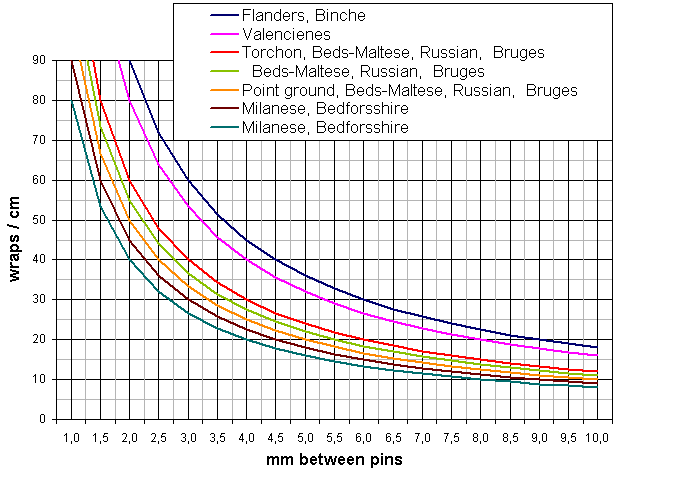
A winding with 12 wraps of thread between pinholes.

| . . | . . | 8 | 9 | 10 | 11 | 12 | 16 | 18 |
| . . | 1.5 | 53 w/cm | 60 w/cm | 67 w/cm | 73 w/cm | 80 w/cm | . | . |
| . . | 1.8 | 44 w/cm | 50 w/cm | 58 w/cm | 61 w/cm | 67 w/cm | . | . |
| . . | 2.0 | 40 w/cm | 45 w/cm | 50 w/cm | 55 w/cm | 60 w/cm | 80 w/cm | . |
| . . | 2.2 | 36 w/cm | 41 w/cm | 45 w/cm | 50 w/cm | 55 w/cm | 73 w/cm | 82 w/cm |
| width | 2.5 | 32 w/cm | 36 w/cm | 40 w/cm | 44 w/cm | 48 w/cm | 64 w/cm | 72 w/cm |
| . . | 2.8 | 29 w/cm | 32 w/cm | 36 w/cm | 39 w/cm | 43 w/cm | 57 w/cm | 64 w/cm |
| of | 3.0 | 27 w/cm | 30 w/cm | 33 w/cm | 37 w/cm | 40 w/cm | 53 w/cm | 60 w/cm |
| . . | 3.2 | 25 w/cm | 28 w/cm | 31 w/cm | 34 w/cm | 38 w/cm | 50 w/cm | 56 w/cm |
| space | 3.8 | 21 w/cm | 24 w/cm | 26 w/cm | 29 w/cm | 32 w/cm | 42 w/cm | 48 w/cm |
| . . | 4.0 | 20 w/cm | 22 w/cm | 25 w/cm | 28 w/cm | 30 w/cm | 40 w/cm | 44 w/cm |
| in | 4.5 | 18 w/cm | 20 w/cm | 22 w/cm | 24 w/cm | 27 w/cm | 36 w/cm | 40 w/cm |
| . . | 5.0 | 16 w/cm | 18 w/cm | 20 w/cm | 22 w/cm | 24 w/cm | 32 w/cm | 36 w/cm |
| mm | 6.0 | 13 w/cm | 15 w/cm | 17 w/cm | 18 w/cm | 20 w/cm | 27 w/cm | 30 w/cm |
| . . | 7.0 | 11 w/cm | 13 w/cm | 14 w/cm | 16 w/cm | 17 w/cm | 23 w/cm | 26 w/cm |
| . . | 8.0 | 10 w/cm | 11 w/cm | 12 w/cm | 14 w/cm | 15 w/cm | 20 w/cm | 23 w/cm |
| . . | 10 | 8 w/cm | 9 w/cm | 10 w/cm | 11 w/cm | 12 w/cm | 16 w/cm | 18 w/cm |
| Milanese | Bedfordshire | Point Ground | Bruges | Torchon | Valenciennes | Binche |

*wraps/cm is the method I use in my book Threads for Lace to compare different thicknesses of thread.
Jo has used the table above to produce a graph showing the relationship of thread thickness and distance between pins for different styles of bobbin lace
More information about this on Bobbin-Lace Wiki pages .

See also Thread size conversions
Thread size conversions
MainLacePage§
LaceGallery§
LacePattern§
Bibliography§
PaperBobbins§
LaceLinks§
ColouredThreads§
CurlyLace§
SnakesGallery§
VariegatedThreads§
BookmarkVariations